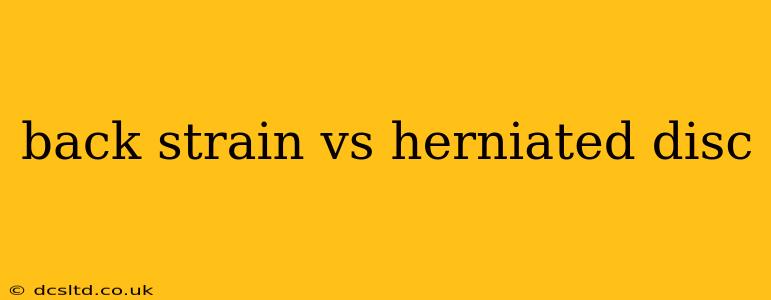Back pain is a common ailment, affecting millions worldwide. Two frequent causes of lower back pain are back strain (muscle strain) and a herniated disc. While both can cause significant discomfort, understanding their differences is crucial for proper diagnosis and treatment. This article will delve into the key distinctions between these two conditions, answering common questions and providing valuable insights for managing back pain.
What is a Back Strain?
A back strain, also known as a muscle strain or sprain, occurs when the muscles or ligaments in your back are overstretched or torn. This often happens due to sudden movements, lifting heavy objects improperly, or repetitive strain. Symptoms typically include:
- Localized pain: The pain is usually felt in the affected muscle area, often improving with rest and gentle movement.
- Muscle spasms: Tightness and spasms in the back muscles are common.
- Tenderness to the touch: The affected area may be sensitive to pressure.
- Limited range of motion: You might find it difficult to bend, twist, or extend your back fully.
Back strains generally heal within a few weeks with rest, ice, over-the-counter pain relievers, and gentle stretching exercises.
What is a Herniated Disc?
A herniated disc, also called a slipped or ruptured disc, occurs when the soft, gel-like center of an intervertebral disc pushes through a tear in the tougher outer layer. This can compress nearby nerves, leading to more severe and radiating pain. Symptoms of a herniated disc can include:
- Radiating pain: Pain often extends down the leg (sciatica) or into the arm, following the path of the affected nerve.
- Numbness and tingling: You might experience numbness, tingling, or weakness in the leg or arm.
- Muscle weakness: Weakness in the affected leg or arm can be a significant symptom.
- Severe pain: The pain associated with a herniated disc can be intense and debilitating.
How Can I Tell the Difference Between a Back Strain and a Herniated Disc?
Differentiating between a back strain and a herniated disc requires a professional medical assessment. While the symptoms can overlap, several key factors can help distinguish them:
- Location and pattern of pain: Radiating pain down the leg or arm strongly suggests a herniated disc. Localized pain is more indicative of a muscle strain.
- Severity of pain: Herniated discs often cause significantly more intense pain than muscle strains.
- Numbness and tingling: These are common with herniated discs but less frequent with muscle strains.
- Muscle weakness: Weakness in the leg or arm is a hallmark symptom of a herniated disc.
How are Back Strains and Herniated Discs Diagnosed?
Diagnosis involves a physical examination by a physician or other healthcare professional. They will assess your symptoms, range of motion, and neurological function. Imaging tests, such as X-rays, MRIs, or CT scans, might be necessary to confirm the diagnosis, particularly in cases of suspected herniated disc.
What is the Treatment for a Back Strain?
Treatment for a back strain usually involves conservative methods:
- Rest: Avoiding strenuous activities is crucial.
- Ice and heat: Applying ice initially (20 minutes on, 20 minutes off) can reduce inflammation. Heat can be used later to relax muscles.
- Over-the-counter pain relievers: Ibuprofen or acetaminophen can help manage pain and inflammation.
- Physical therapy: A physical therapist can teach you exercises to strengthen your back muscles and improve flexibility.
What is the Treatment for a Herniated Disc?
Treatment for a herniated disc depends on the severity of symptoms. Conservative treatments similar to back strain management are often tried first. However, more aggressive interventions might be necessary if conservative treatment fails:
- Epidural steroid injections: These injections can reduce inflammation and pain around the nerve roots.
- Physical therapy: Strengthening and stretching exercises are essential.
- Surgery: In severe cases, surgery might be necessary to decompress the nerve or repair the damaged disc.
Can a back strain lead to a herniated disc?
While a back strain itself doesn't directly cause a herniated disc, repetitive strain or improper lifting techniques that lead to frequent muscle strains can contribute to the eventual degeneration of the intervertebral discs, increasing the risk of herniation over time.
What are the long-term effects of untreated back strain and herniated disc?
Untreated back strains can lead to chronic pain and limited mobility. Similarly, untreated herniated discs can result in persistent pain, nerve damage, and potentially more serious complications requiring surgery. Early diagnosis and treatment are crucial for optimal outcomes.
This information is for educational purposes only and does not constitute medical advice. If you are experiencing back pain, consult a healthcare professional for an accurate diagnosis and personalized treatment plan. Remember that early intervention is key to effective management of back pain, regardless of the underlying cause.
